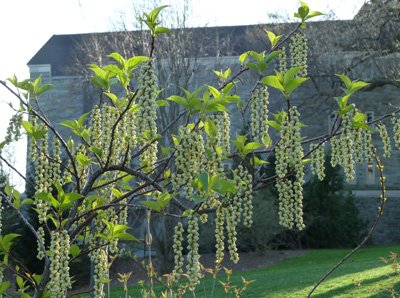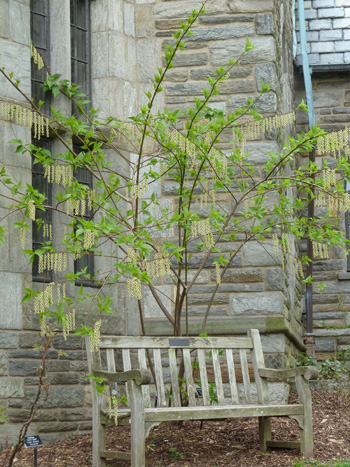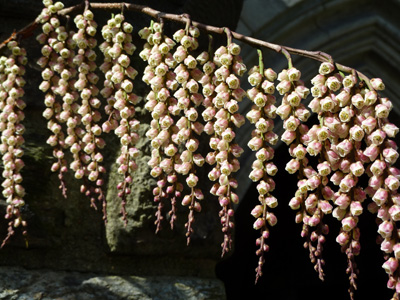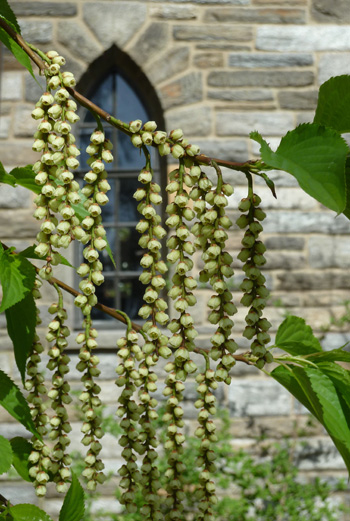Stachyurus: Spring Spiketails
 Spring offers a flurry of flowers and color – Magnolia, Prunus, Corylopsis, Edgeworthia, camellias, bulbs, and spring ephemerals vie for attention. With so many showstoppers it can be difficult to stand out from the crowd. One plant that has been able to shine as brightly as the aforementioned plants, a plant that isn’t commonly seen in many gardens, is Stachyurus.
Spring offers a flurry of flowers and color – Magnolia, Prunus, Corylopsis, Edgeworthia, camellias, bulbs, and spring ephemerals vie for attention. With so many showstoppers it can be difficult to stand out from the crowd. One plant that has been able to shine as brightly as the aforementioned plants, a plant that isn’t commonly seen in many gardens, is Stachyurus.

Stachyurus praecox var. matsuzakii arching branches create a fountain-like effect behind this bench. photo credit: J. Coceano
Stachyurus is a genus of primarily deciduous shrubs native to Asia. The most common, Stachyurus praecox, is found throughout Japan where it thrives in soils that are moist, humus-rich, and slightly acidic. Plants reach 4-10’ tall with a similar spread. The shrub creates a fountain-like effect with arching branches and an overall rounded profile. Alternate, simple, lustrous leaves clothe the plant throughout the growing season. Stachyurus shines in the spring when abundant flowering racemes hang suspended from bare branches.

Stachyurus praecox racemes average 3-5” in length and create a string-of-pearls effect.photo credit: J. Coceano
Racemes, originating from leaf axils, are composed of numerous bell-shaped, four-petaled flowers. Each raceme, averaging 3-5” in length, creates a string-of-pearls effect. Stachyurus praecox bears yellow-green flowers while the outer petals of S. praecox ‘Rubriflora’ is blushed with soft rose. Flowers are produced on old wood so pruning should be completed immediately after flowering. Mature plants have a tendency to produce an erratic flowering shoot – simply prune to the base of the plant.

Commonly called spiketails, these are the racemes of Stachyurus chinensis 'Magpie'. photo credit: J. Coceano
Stachys is Greek for spike while oura translates to tail referencing the suspended flower racemes. Plants in this genus are commonly called spiketails. The specific epithet praecox means early. Depending on site, weather, and geographical location, flowers can emerge from early March through late April.

Stachyurus praecox 'Rubriflora' in bloom. photo credit: J. Coceano
The Stachyurus collection at The Scott Arboretum is diverse with most plants located within the Winter Garden, around Clothier Hall, and near the Cunningham House and Wister Center. Stachyurus chinensis ‘Magpie’ bears the longest racemes while S. praecox ‘Aurea Variegata’ shines front and center near the main entrance to the arboretum offices. S. praecox var. matsuzakii creates a canopy over a bench in the Peony Collection. While most stachyurus are deciduous, S. yunnanensis is the exception. The evergreen shrub usually loses its leaves over the course of our Swarthmore winters. Not so this year! According to Andrew Bunting, curator, this is the first winter the plant has retained its shiny leaves.

Stachyurus praecox var. matsuzakii found in the Tree Peony Collection. photo credit: J. Coceano
The genus isn’t affected by any serious insect or disease problems. Consider adding spiketail to the shrub border or woodland garden. Plants have been trained against walls to accentuate the form and pendulous flowers. Regardless of location, the shrub is sure to delight.





Nancy Buley
Posted at 00:21h, 05 AprilOne of the great late winter, early spring plants! I love this plant, and it is all the more beautiful against a background of the beautiful stone buildings of Swarthmore College. Thank you for a great article and photos!
Josh Coceano
Posted at 20:14h, 05 AprilThank you, Nancy. A backdrop of stone helps highlight the blooms of Stachyurus. Darker backdrops seem especially effective.
Jared Barnes
Posted at 06:10h, 06 AprilLOVE LOVE LOVE Stachyurus! Great read; great pics. The flower color pops against the buildings.
Val Wilkes
Posted at 17:54h, 13 AprilA favorite among “hortheads”-personally, I just don’t get it. Homely, gangly, rangy and I hesitate to say because I know people will hate me for this one-UGLY. It is very easy to grow after 3 years I’m ripping it out for something more attractive.
Monika Watts
Posted at 01:04h, 05 AugustJust found your article. Thanks for all the information and the pictures. Needed to check for pruning – obviously not in August, so wait for next year. One little bit of information I would have welcomed: How to take cuttings.
I looked for this plant for nearly eight years after a visit to Japan; garden centres do not seem to like it.